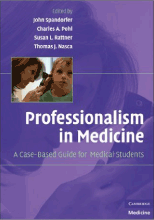
|
|
Spandorfer J, Pohl C, Nasca T, Rattner SL, eds. Professionalism in Medicine : A Case-Based Guide for Medical Students. Cambridge: Cambridge University Press; 2010.
|
| Thomas Jefferson University |
Video: Commitment to Improving the Quality of Care | Commentaries
A Faculty Perspective
Medicine is, and always has been, a team activity. We are only now beginning to understand how important teamwork is in providing patient-centered, effective and safe care. In both inpatient and outpatient academic settings, students are an important member of the interdisciplinary team. As Mr. Goyal points out, students are often in a position to spend more time with patients. This "extra" time with patients can have several positive consequences. First, students can develop a meaningful, human relationship with patients as the student learns more about who the patient is as a person; this is especially true during a chaotic hospital admission. Second, students will often explore the medical history and physical exam in greater depth, and as a result may uncover findings missed by others on the healthcare team.
One might assume that students may uncover historical and physical exam findings missed by others simply because they may have more time to conduct a thorough history and exam. However, some evidence suggests that students may be every bit as competent as their attendings in some skills. For example, Vukanovic-Criley and colleagues found the cardiac examination skills of both full-time and volunteer faculty were no better than those of third or fourth year students (1). Mr. Goyal's experience with the heart murmur is certainly testament to this research finding. Students were also found to be positive contributors to quality improvement in community-based faculty outpatient offices, helping those practices identify opportunities for improvement through medical record audits (2). Thus, students bring important and useful knowledge and skills to the care of patients.
However, the hierarchical nature of physician and local medical culture can have a pernicious effect on students wanting to point out potential problems, errors or unique information about patients. Students clearly see themselves as the bottom of the academic food chain; much in their environment supports this perception. First, students are highly dependent on faculty for grades and may be reticent to point out an oversight or missed finding by an attending. Second, faculty often spend limited time with students, and that time is often shared with other learners on the team. Third, as Mr. Goyal points out, physicians in the outpatient setting are often harried in today's practice environment, and students may perceive any disruption to workflow as unwelcome. However, beyond issues associated with hierarchy, one of the biggest barriers to the professional development of medical students is the hidden curriculum. The hidden curriculum is defined as "the set of influences that function at the level of organizational structure and culture, including for example, implicit rules to survive the institution such as customs, rituals, taken for granted aspects" -- a set that can be positive and/or negative (3). In our current vignette, an attending and office staff dismissive of the student's concern about the patient's drinking would be sending a strong message to the student to "stay out of the way," at substantial risk to the patient. On the other hand, an attending that acts on the information uncovered by the student, even if she neglects to give the student positive feedback, is sending a powerful message that the student is a valued member of the office team.
In a recent review, Baker and his colleagues developed a core set of teamwork competencies (4). Three of these competencies are pertinent to our vignette: team leadership, mutual performance monitoring and mutual trust. In Baker's model of team competencies several key leadership behaviors include facilitating problem solving and synchronizing the individual team member contributions. Clearly both behaviors apply to the student's role in caring for this at-risk patient.
For mutual performance monitoring and trust, identifying mistakes and lapses in other team member actions, sharing information (in this case the alcohol use) and the willingness to admit mistakes and accept feedback are crucial behaviors to ensure patient safety and effective care; imagine the powerful message sent if the attending admitted his or her own mistake to a student but more importantly acted on the event to learn and improve their own future performance.
Professionalism can only be known in and through action. This vignette highlights the important potential behaviors by both the student and the attending that are essential to ensure this patient receives patient-centered, effective and safe care.
References:
- Vukanovic-Criley JM. Criley S. Warde CM. Boker JR. Guevara-Matheus L. Churchill WH. Nelson WP. Criley JM. Competency in cardiac examination skills in medical students, trainees, physicians, and faculty: a multicenter study. Arch Intern Med. 2006; 166: 610-6.
- Gould BE. Grey MR. Huntington CG. Gruman C. Rosen JH. Storey E. Abrahamson L. Conaty AM. Curry L. Ferreira M. Harrington KL. Paturzo D. Van Hoof TJ. Improving patient care outcomes by teaching quality improvement to medical students in community-based practices. Acad Med. 2002; 77: 1011-8.
- Hicks LK, Lin Y, Robertson DW, Robinson DL, Woodrow SI. Understanding the clinical dilemmas that shape medical students' ethical development: questionnaire survey and focus group study. BMJ. 2001; 322: 709-10.
- Baker DP, Salas E, King H, Battles J, Barach P. The role of teamwork in the professional education of physicians: current status and assessment recommendations. Jt Comm J Qual Patient Safety. 2005; 31: 185-202.
Eric Holmboe, M.D.
Senior Vice President for Quality Research and Academic Affairs
American Board of Internal Medicine
Philadelphia, PA